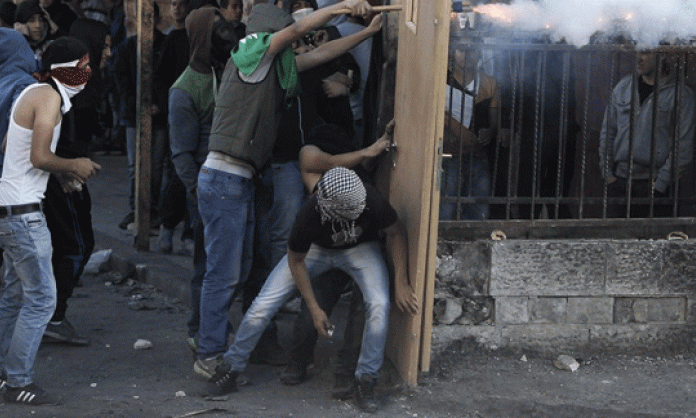Tension continues to rise in occupied East Jerusalem after Israeli occupation forces severely injured two Palestinian children.
On 14 November, 10-year-old Mayar al-Natsheh’s skull was fractured when troops fired on the car she was in at a checkpoint near Shufat refugee camp.
A day earlier, Israeli police shot 11-year-old Saleh Mahmoud in the face, at close range, with a “sponge” bullet – high density plastic with a sponge tip fired from a grenade launcher. He was blinded in his left eye, and the vision in his right eye has been severely impaired.
At the time of the shooting, residents of al-Issawiya were protesting the closure of three of the four entrances to their village for more than 11 days.
East Jerusalem has been a tinderbox since the brutal torture and murder of 16-year-old Mohammed Abu Khdeir by Israeli settlers on 2 July. Abu Khdeir was forced to drink gasoline before being burnt alive.
Israel’s brutal 50-day bombardment of Gaza only added to the outrage.
The Palestinian Arab residents of East Jerusalem have been staging continuous protests against Israel’s atrocities and the ongoing occupation. Viewed as a fifth column and a “demographic time bomb” – a threat to Jewish dominance in Israel – Palestinians face systemic discrimination on all levels, in both the occupied territories and the Israeli state.
Discontent has been further inflamed as a result of Israel restricting access to the Al-Aqsa mosque and attempts by Israeli settlers to gain control of the Temple Mount, where the mosque is located. The settlers, who have the support of both government officials and Israeli police, have been agitating for the destruction of the mosque, one of Islam’s holiest sites.
The rising tensions resulted in an attempt to assassinate dual US-Israel citizen Yehuda Glick, the illegal settler at the forefront of the campaign to destroy the mosque. Israeli police later assassinated a Palestinian man, Moataz Hejazi, who they claimed was responsible for the shooting of Glick.
A week after the extrajudicial execution of Hejazi, Israeli police executed 22-year-old Kheir al-Dein Hamdan in Kafra Kana. The following day, 8 November, a general strike was widely observed throughout Palestinian communities inside Israel, and Palestinian youth took to the streets.
In statement issued on 9 November, Adalah, the Legal Centre for Arab Minority Rights, noted that the killing was captured on a nearby CCTV camera and clearly showed an execution. Hamdan “did not pose any immediate threat to the lives of the police officers when they shot him down”, Adalah said, adding that “the police narrative was false and fabricated”.
The centre also noted a direct connection between the execution of Hamdan and the statements made the previous week by public security minister Yitzhak Aharonovich, who had said that anyone attacking Israeli Jewish citizens should be killed.
In response to the escalating protests in East Jerusalem, prime minister Netanyahu’s cabinet approved a law change that would increase the maximum penalty for stone throwing to 20 years in prison. According to the Jerusalem Post, Netanyahu told his cabinet: “Israel is acting firmly against terrorists, rock-throwers, against firebomb throwers and against those who use fireworks.”
Israel’s most read Hebrew daily, Yedioth Ahronoth, on 5 November outlined Netanyahu’s hardline approach to the East Jerusalem protests. The paper quoted Israel Security Agency head Yoram Cohen as saying that Netanyahu is “strongly convinced by the effectiveness of [collective] punishments: the imposition of prison sentences and fines for parents whose children throw stones, the demolition of houses, deportation to the Gaza Strip, the collection of taxes by force”.
All of these measures are breaches of international law.










